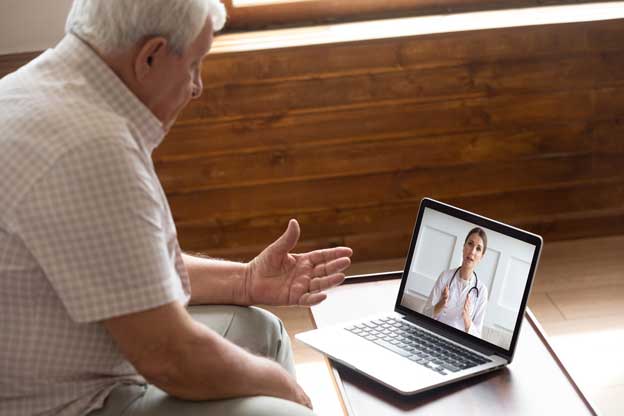Choosing the right remote patient monitoring solution for your Medicare patients

Reaching seniors at home with remote patient monitoring during COVID-19
US adults over the age of 65 have the highest risk for mortality when infected with COVID-19. Many seniors who are sick have limited financial resources, and significant technology barriers, making this population the most susceptible to severe illness when infected with the COVID-19 virus.
During the COVID-19 pandemic, it’s become crucial to keep chronic care seniors at home, as they have the highest mortality rate. 73% of those hospitalized for the virus have a preexisting condition, and COVID-19 kills 13% of patients ages 80 and older. But continuing to provide care by monitoring and treating their chronic conditions during this time is critical. If their conditions — diabetes, obesity, and congestive heart failure — become unmanaged, it can result in potentially catastrophic and expensive outcomes, further stressing the healthcare system.
Even during “normal times,” going to a medical office or clinic for seniors has been logistically challenging, as approximately half have transportation barriers to get to their doctor. With the COVID-19 pandemic, going to the office can be life-threatening, as it heightens their risk of infection.
Growing need to serve seniors at home during the COVID-19 pandemic
COVID-19 is changing how doctors, nurses, and the medical community can safely treat patients. Remote care, including telemedicine and remote patient monitoring, has come to the forefront as an effective method of maintaining social distancing protocols while providing necessary care to an at-risk senior population.
Below are some ways to take action to help your senior patients navigate a real threat to their health during this unprecedented pandemic and choose the right remote patient monitoring devices.
Choosing the right RPM devices during COVID-19
There are a handful of companies touting remote patient monitoring services and devices, but which devices should you equip your patients with during this pandemic? The answer lies in assessing symptoms and risks.
In addition to monitoring existing chronic care conditions, medical practitioners should be able to assess common COVID-19 symptoms without exposing patients to additional risk.
The list below outlines five devices that can help practitioners assess symptoms and preexisting conditions that are known to cause severe illness with COVID-19:
Thermometer
According to the CDC, fever and chills are common symptoms of COVID-19. Understanding which of your patients are experiencing elevated temperatures without having to come into the office and potentially expose other patients and practitioners could be lifesaving. Practitioners are able to act immediately on new clinical data when alerted of out of range temperatures and can recommend COVID-19 testing or treatment, depending on the best course of action.
Oxygen sensor
COVID-19 can cause shortness of breath and/or difficulty breathing, leading to low tissue and blood oxygen levels. A pulse oximeter that sends blood oxygen data from the patient directly to the practitioner can help to assess concerns of “silent hypoxia” and catch early signs of shortness of breath that may not be readily apparent.
If a patient was recently released after having COVID-19, it’s important to monitor their oxygen levels as they recover to help ensure an optimal recuperation.
Blood Glucose Monitor
Preexisting conditions have become understood over the course of the COVID-19 pandemic as an indicator of the predicted severity of the virus, including diabetes. Diabetes has been linked to increased mortality with COVID-19, so monitoring patients with diabetes and pre-diabetes can provide practitioners with COVID-19 relevant data and clinical information at-a-glance so doctors and nurses can make better decisions on patient care.
Digital Weight Scale
One of the most noted preexisting conditions linked to mortality with COVID-19 is obesity, so practitioners must follow patient weight trends to prevent or treat weight-related disease in their population.
A remote monitoring weight scale can also help practitioners detect and track congestive heart failure (CHF) in senior patients.
Blood Pressure Cuff
People with high blood pressure, or hypertension, might be at risk for severe illness when infected with COVID-19. Remotely monitoring patients’ blood pressure enables practitioners to treat hypertension and potentially reduce the risk of severe illness during this global pandemic.
The right RPM solution will enable practitioners to monitor and get notified if a patient’s blood pressure is out a defined safe range to escalate urgent cases and prioritize care accordingly.
Learn the benefits of RPM devices for your patients during COVID-19
These five devices could help bring symptoms of COVID-19 to a practitioner’s attention or diagnose and treat a preexisting condition known to correlate with severe illness when infected with the virus.
100Plus is one of a few RPM companies that offer an out of the box turnkey RPM solution based on cellular technology. They also offer a full service at no cost to the medical practices to enroll their patients in the RPM care program.
Learn the benefits of remote patient monitoring (RPM) for your patients during this global pandemic today. Request a demo of the fastest-growing remote patient monitoring platform for doctors and their patients in the age of COVID-19.